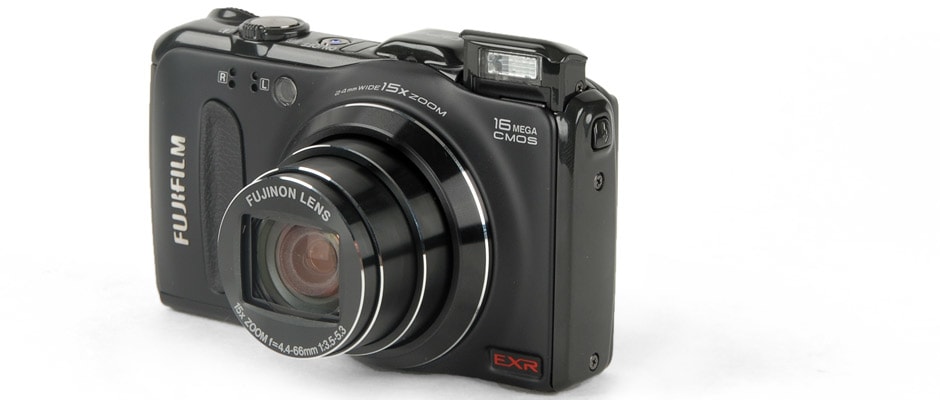Pros
Cons
Introduction
Looking at the body and spec sheet, the F600EXR is almost identical to its predecessor, sporting the same 1/2-inch CMOS sensor, 15x Fujinon zoom lens, EXR processor, built-in GPS unit, body, and, uh, pretty much everything else. But Fuji claims that there are a handful of improvements under the hood: much faster autofocus, re-tooled motion detection, "intelligent" digital zoom systems, and a new landmark navigation function. Those sound like updates that could've been accomplished with new firmware rather than a separate camera, but nevertheless, the F600EXR is here. Our tests found some promising results, though not without a few "ifs," "ands," and "buts" to juggle.
Design & Usability
{{section_header}}{{section.name}}{{/section_header}}
As with most pocket-sized devices, the F600EXR's body is less than ideal, but the control layout is well-executed.
All pocket-sized cameras sacrifice in-hand comfort for extra portability, and the F600EXR is no different. Its slim rectangular body is slippery, and it's a fingerprint magnet too, but a few grip points on the right side make for better leverage. Handling is also helped by the fact that buttons and dials are all positioned comfortably. To anyone with a bit of digital camera experience, the control scheme here should look pretty familiar. There's a power switch and shutter/zoom-tilter combo up top, and a handful of function buttons on the rear. The main menu has two main tabs, one for shooting and one for setup. Some setup options arguably belong in the shooting section (RAW capture and GPS control, to name two), but the menu is otherwise logical and easy to navigate too, thanks to the selection dial. Users can also utilize the quicker F menu, which brings up commonly adjusted settings without leaving live preview. Lastly, the well-placed mode dial, angled toward the user, is easy to rotate with just one hand. Overall control is greatly enhanced by this dial, as it eases the process of cycling through large sets of photos and long menus.
As for hardware, the Finepix does not have a viewfinder (no surprise), so framing and navigation are handled on the 3-inch, 460k-pixel LCD. The F600EXR'S flash is a small pop-up unit on the top-left of the camera body. This is exactly where most photographers tend to rest their left index fingers, which can be irritating, but at least it won’t pop up automatically. Users control the flash with a dedicated release button.
{{photo_gallery "Front Photo", "Back Photo", "Sides Photo", "Top Photo", "Bottom Photo", "Lens Photo", "Lens Photo 2", "3D Lens Photo", "Media Photo", "Easy Mode Photo", "Manual Controls Photo 1", "Manual Controls Photo 2", "Zoom Photo", "Zoom Photo 2", "Ease of Use Photo", "Battery Photo", "LCD Photo 1", "LCD Photo 2", "EVF Photo 1", "EVF Photo 2", "Ports Photo 1", "Ports Photo 2", "Ports Photo 3", "Ports Photo 4", "Ports Photo 5", "Ports Photo 6", "Handling Photo 1", "Handling Photo 2", "Handling Photo 3", "Handling Photo 4", "Buttons Photo 1", "Buttons Photo 2", "Buttons Photo 3", "Box Photo"}}
Features
{{section_header}}{{section.name}}{{/section_header}}
This F600EXR offers tons of control, both auto and manual.
The F600EXR offers tons of control, both auto and manual. PASM modes, auto modes, and scene presets all decorate the mode dial. Like most higher-end travel zooms, this one offers a rich set of manual controls, including Aperture/Shutter Priority, Manual modes, and RAW image capture. Interestingly, RAW photos are not eligible for alteration in this camera's basic in-camera editing suite.
Creative control extends further with 21 scene modes. These cover old standbys like Landscape and Portrait, as well as more advanced settings like 360-degree sweep panorama and soft background mode. There are no effects or filters, but Fujifilm included some nostalgic color modes, which they call Film Simulations. A far-reaching lens and clever flash are the hardware highlights on this camera, plus its GPS. The built-in GPS enables geo-tagging and landmark navigation, but like most of these small, in-camera units, it works best in open locations rather than crowded urban areas. A Fujinon 4.4-66mm (24-360mm equivalent) f/3.5-5.6 lens dominates the front of the camera. An enclosure covers the lens when powered off, and automatically opens when it's powered on, and the zoom ratio is a healthy 15x. The video mode is about what we expect out of a $350 travel zoom; it’s a useful extra feature, though not developed enough to make it a worthy standalone camcorder.
Performance
{{section_header}}{{section.name}}{{/section_header}}
The F600EXR delivers a fine photo, and it doesn't crumble in low-light.
In the biggest sense, the F600EXR's image quality is satisfactory. Colors are quite accurate, while the "Film Simulation" color modes offer a touch of nostalgia if users so desire. Generally, blues and reds tend to be a bit exaggerated, but color looks nice on the whole. Noise levels are significant, but photos still look clear and detailed thanks to hands-off reduction software. It's helpful to keep in mind that just because a picture is noisy, that doesn't mean that it necessarily looks bad. When you're looking at a messy, splotchy photo from a point-and-shoot at ISO 1600, it's usually the software-based, noise-reducing image processing that ruined the shot. Thus, since the Fujifilm F600EXR applies noise-reducing software judiciously, its images look nice despite the noise levels. Moreover, image quality improves even further using the EXR modes; though we shot our official test photos with Program mode, which produced nice results, we also ran some tests on the EXR settings and they always returned better scores—especially in terms of noise.
Notably, this camera actually returned consistently cleaner results in low light than in bright light. The F600EXR shoots full-res shots from ISO 100 through ISO 3200, and at reduced resolutions, it can even leap to a whopping ISO 12800. Finally, resolution is decent for such a far-reaching lens, but images get soft along the edges compared with the crisp centers. On top of that, purple fringing (a type of light distortion that pollutes high-contrast borders) is quite apparent through the focal range at the edge of the frame, while green fringing is notable at the center.
Conclusion
{{section_header}}{{section.name}}{{/section_header}}
Beginners may flounder in the F600EXR's flood of controls.
The Fujifilm F600EXR is a well-executed travel zoom, one that a casual photographer could bring on vacation and learn to love, though it's really designed with hands-on, enthusiast shooters in mind. Its defining characteristic is control. Several travel zooms offer manual control, but very few can shoot the RAW format that photo geeks demand. Even its automatic modes function at a higher level, thanks to Fujifilm's EXR processing. The interface could use a facelift and an assignable function key, but navigation is otherwise pretty friendly.
There's a bit of a learning curve with this camera, and though it's worth it in the long-run to work through it, this curve makes us hesitate to recommend it to everyone. With two auto modes and tons of shooting settings, it might be a bit more complicated than the average point-and-shoot buyer wants. It really doesn't have any hand-holding features, and it has very few of the fun extras like photo effects and filters that make compact cameras so endearing to so many. That said, the F600EXR is a very solid camera. F550EXR owners don't need to bother upgrading, but the new model is notably faster, which is good news for prospective buyers. It won't appeal to everyone, but we heartily recommend it to enthusiast photographers who want an all-in-one, carry-anywhere camera.
Science Introduction
{{section_header}}{{section.name}}{{/section_header}}
Though testing showed that the F600EXR's colors were accurate and its resolution was decent, none of the scores exactly blew us away. Noise levels were significant, but photos still looked clear and detailed, thanks to hands-off reduction software. Soft edges and chromatic aberration plagued images here and there, and video performance was just average. Overall, results were solid, not extraordinary.
Color, Sharpness, and Resolution
{{section_header}}{{section.name}}{{/section_header}}
The F600EXR earned a strong color accuracy score, and sharpness and resolution were decent for such a far-reaching lens.
Color accuracy came out strong in testing. Standard mode—the Provia "film simulation" setting, as Fuji calls it on this camera—is the most accurate and the most reasonably saturated, with a mean color error of 2.85 (anything under 3.0 is quite good) and 104 percent saturation. Blues and reds tend to be a bit exaggerated, but the rest of the shades are pretty accurate.
Overall, the F600EXR earned decent—not excellent—resolution scores. Our official score is based on test shots taken in Program mode, but we ran a separate test with shots taken with the Resolution Priority EXR processing mode, which produced a small but notable improvement in terms of both sharpness and distortion. Neither result blew us away, but the overall numbers are respectable for a long-zooming lens with a wide starting point.
The sharpness score is decent overall, but the edges are super-soft compared to the crisp center. It's a feat of engineering that we can have such a versatile zoom range in such a small camera, so we aren't surprised that the sharpness is less than ideal, but the edges are too blurry.
{{photo_gallery "Science Section 1 Images"}}
Noise Reduction
{{section_header}}{{section.name}}{{/section_header}}
Noise levels are significant, but photos still look clear and detailed thanks to hands-off reduction software.
If a photo you took with a point-and-shoot at ISO 1600 looks messy and splotchy, it's likely because noise-reducing image processing ruined the shot, not so much the hardware-based chroma and luma noise. Keep that in mind as you parse these results.
The F600EXR returned pretty significant noise levels in our tests, an average of 1.33% noise across all full-res ISO settings in bright and dim light. Noise levels start pretty low at the base but rise quickly up through ISO 800. Noise drops back a bit at ISO 1600 thanks to some noise reduction, and then spikes up above the 2% mark at ISO 3200, the top full-res setting. At ISO 800, images are pretty sharp, despite some grain, but images soften a bit at ISO 1600.
{{photo_gallery "Science Section 2 Images"}}
Distortion
{{section_header}}{{section.name}}{{/section_header}}
Distortion is mostly well controlled on the F600EXR.
Testing revealed slight barrel distortion at the wide angle, more significant barrel distortion in the middle of the range, and slight pincushioning at the telephoto setting. Additionally, purple fringing is quite apparent through the focal range at the edge of the frame, while green fringing is notable at the center.
{{photo_gallery "Science Section 3 Images"}}
Video
{{section_header}}{{section.name}}{{/section_header}}
Video performance is not such that it can substitute a standalone camcorder.
The F600EXR’s video mode is capable of 1080p movies at 30 frames per second. Operation is almost entirely automated, with little user control over exposure. Optical zoom does work during filming, and the F600EXR can also grab 8-megapixel photos without interrupting the recording. Autofocus locks once at the beginning of a clip, but can’t re-adjust in the middle of recording except when capturing a still photo—it’s a wonky workaround that didn’t earn any points, but it’s there if you need it.
Colors are accurate and well saturated, at least compared to the funky, flat hues that most compact cameras’ video modes spit up. For a 1080p-shooting camera, we expected the F600EXR to be sharper than it actually is though. Our score does come with a bit of a caveat: Stationary objects look exceptionally clear and detailed, but as soon as anything starts to move, the definition starts to get muddled—particularly with vertical motion.

Meet the tester
Liam manages features and news coverage for Reviewed.com. Formerly the editor of the DigitalAdvisor network, he's covered cameras, TVs, personal electronics, and (recently) appliances. He's a native Bostonian and has played in metal bands you've never heard of.
Checking our work.
Our team is here to help you buy the best stuff and love what you own. Our writers, editors, and experts obsess over the products we cover to make sure you're confident and satisfied. Have a different opinion about something we recommend? Email us and we'll compare notes.
Shoot us an email

